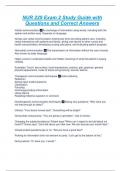NUR 229 Exam 2 Study Guide with
Questions and Correct Answers
Verbal communication ✅An exchange of information using words, including both the
spoken and written word. Depends on language.
Nurses use verbal communication extensively when providing patient care, including
verbal interactions with patients and family, giving oral reports to other nurses and
health care providers, developing nursing care plans, and evaluating patient progress.
Nonverbal communication ✅The transmission of information without the use of words.
Also known as body language.
Helps nurses to understand subtle and hidden meanings in what the patient is saying
verbally.
Examples: Touch, eye contact, facial expressions, posture, gait, gestures, general
physical appearance, mode of dress and grooming, sounds, silence
Therapeutic communication techniques ✅Active listening
Reflection
Asking open ended questions
Clarification
Focusing
Informing/providing information
Using silence
Restating/reflective question or comment
Nontherapeutic communication techniques ✅Asking why questions: "Why were you
not tired enough to sleep?"
Cliches: "Your doctor knows best", "Everything will be alright"
Giving false reassurance: "You are going to get better". Use of cliches.
Changing the subject/avoidance: Patient says "When can I expect to be told about my
insulin?" Nurse says: "Let's talk about your diet now. We can discuss your insulin later."
Closed-ended questions/yes or no: "Did you have a good day?"
Probing for information (info not relevant to care): "Let's get to the bottom of this."
Giving advice: "If I were you, I would.."
, Leading questions: "You aren't going to smoke that cigarette, are you?"
Communication containing judgment: "You aren't acting very grown up. How do you
think your husband would feel if he saw you crying like this?"
Gossip and rumor
Process of communication ✅Source (encoder), message (verbal or nonverbal),
channel (visual, auditory, kinesthetic), and receiver (decoder)
Impaired verbal communication patients ✅Difficulty speaking; slurred speech;
inappropriate verbalization; inability to speak language of caregiver.
Nursing interventions: Learn patient needs and pay attention to nonverbal cues, provide
an alternative means of communication (whiteboard, flash cards), never talk in front of
the patient thinking they can't hear you.
Role of nurse in teaching ✅Maintaining and promoting health
Preventing illness
Restoring health
Facilitating coping
Maintaining and promoting health ✅Nurses can help patients to value health and
develop specific health practices that promote wellness.
Ex. Developmental and maturational issues, normal childbearing, hygiene, nutrition,
exercise, mental health, spiritual health
Preventing illness ✅Educational intervention related to illness prevention, a major
theme in health teaching and counseling, takes many forms.
Ex. First aid, safety, immunizations, screening, identification and management of risk
factors
Self-efficacy ✅An individual's belief that he or she is capable of performing a task.
Ability to learn ✅depends on physical and cognitive abilities, age/developmental level,
physical wellness, thought processes
Learning environment ✅privacy, room temperature, lighting, noise, furniture, ventilation
Factors affecting patient learning ✅Age and developmental level
Family support networks
Financial resources
Cultural influences




